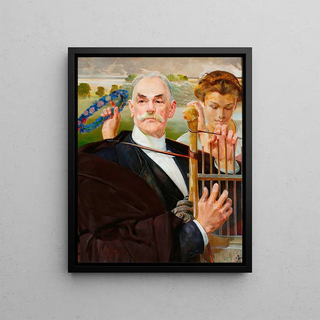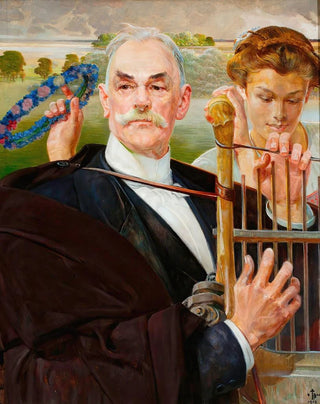Art print | Portrait of Władysław Łęcki - Jacek Malczewski


View from behind

Frame (optional)
Władysław Łęcki Art print by Jacek Malczewski – Captivating Introduction
The "Władysław Łęcki" art print by Jacek Malczewski is a piece that transcends the simple frame of painting to become a true testament to the Polish soul at the end of the 19th century. In this depiction, the artist captures not only the physical features of his subject but also a deeper essence, an introspection that invites the viewer to delve into Łęcki's personal universe. This portrait, rich in emotion and symbolism, resonates like an echo of the struggles and aspirations of a time marked by political and social upheavals. Contemplating this work, one cannot help but be struck by the depth of the exchanged gazes between the painter and his model, a connection that transcends time.
Style and uniqueness of the work
Jacek Malczewski's style is both unique and emblematic of Polish symbolism. In this portrait, mastery of color and finesse of detail blend to create an atmosphere that is both intimate and universal. The delicate nuances of the skin, the play of light on Łęcki's face, as well as carefully chosen background elements, testify to a meticulous approach and a keen sense of composition. Every brushstroke seems loaded with meaning; each element of the painting is an invitation to explore the thoughts and emotions of the character. The psychological depth of this work reveals itself gradually, unveiling a rich and complex inner world where melancholy coexists with hope.
The artist and his influence
Jacek Malczewski, an emblematic figure of Polish art, established himself as a master of symbolism, influencing many artists throughout his career. His ability to blend the real and the fantastical, to evoke universal themes through personal stories, marked a generation of artists. Malczewski does not merely depict the world as it is; he transforms it into a canvas of meanings, where each element carries a message. His work, deeply rooted in Polish culture, addresses questions of identity,

Matte finish

View from behind

Frame (optional)
Władysław Łęcki Art print by Jacek Malczewski – Captivating Introduction
The "Władysław Łęcki" art print by Jacek Malczewski is a piece that transcends the simple frame of painting to become a true testament to the Polish soul at the end of the 19th century. In this depiction, the artist captures not only the physical features of his subject but also a deeper essence, an introspection that invites the viewer to delve into Łęcki's personal universe. This portrait, rich in emotion and symbolism, resonates like an echo of the struggles and aspirations of a time marked by political and social upheavals. Contemplating this work, one cannot help but be struck by the depth of the exchanged gazes between the painter and his model, a connection that transcends time.
Style and uniqueness of the work
Jacek Malczewski's style is both unique and emblematic of Polish symbolism. In this portrait, mastery of color and finesse of detail blend to create an atmosphere that is both intimate and universal. The delicate nuances of the skin, the play of light on Łęcki's face, as well as carefully chosen background elements, testify to a meticulous approach and a keen sense of composition. Every brushstroke seems loaded with meaning; each element of the painting is an invitation to explore the thoughts and emotions of the character. The psychological depth of this work reveals itself gradually, unveiling a rich and complex inner world where melancholy coexists with hope.
The artist and his influence
Jacek Malczewski, an emblematic figure of Polish art, established himself as a master of symbolism, influencing many artists throughout his career. His ability to blend the real and the fantastical, to evoke universal themes through personal stories, marked a generation of artists. Malczewski does not merely depict the world as it is; he transforms it into a canvas of meanings, where each element carries a message. His work, deeply rooted in Polish culture, addresses questions of identity,






